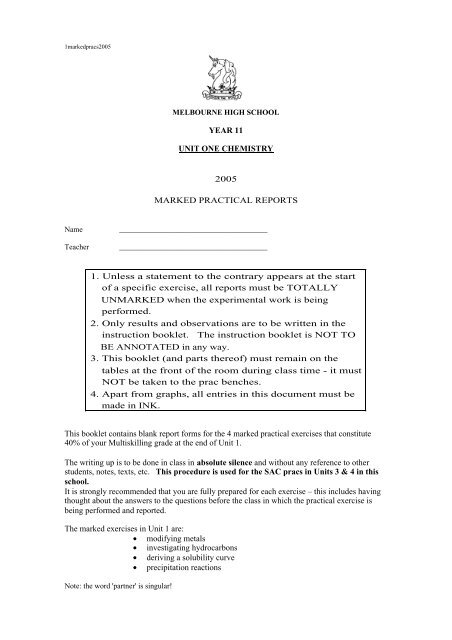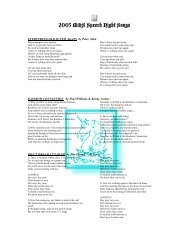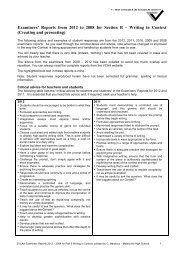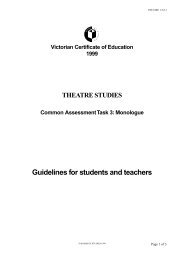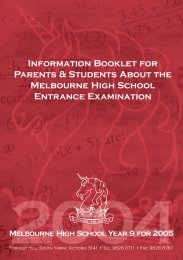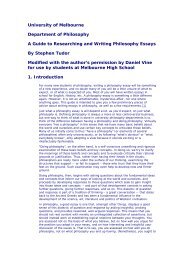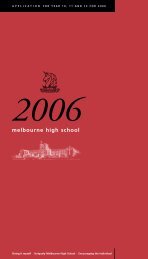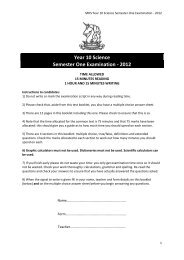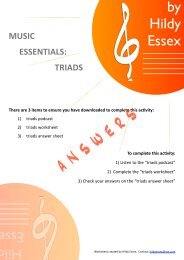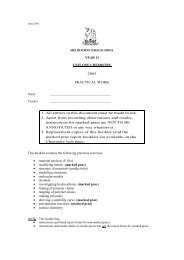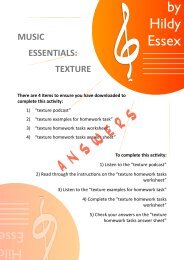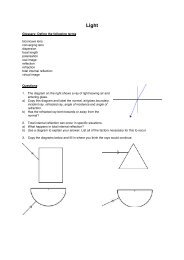YEAR 11 UNIT ONE CHEMISTRY 2005 MARKED PRACTICAL ...
YEAR 11 UNIT ONE CHEMISTRY 2005 MARKED PRACTICAL ...
YEAR 11 UNIT ONE CHEMISTRY 2005 MARKED PRACTICAL ...
You also want an ePaper? Increase the reach of your titles
YUMPU automatically turns print PDFs into web optimized ePapers that Google loves.
1markedpracs<strong>2005</strong>MELBOURNE HIGH SCHOOL<strong>YEAR</strong> <strong>11</strong><strong>UNIT</strong> <strong>ONE</strong> <strong>CHEMISTRY</strong><strong>2005</strong><strong>MARKED</strong> <strong>PRACTICAL</strong> REPORTSNameTeacher______________________________________________________________________________1. Unless a statement to the contrary appears at the startof a specific exercise, all reports must be TOTALLYUN<strong>MARKED</strong> when the experimental work is beingperformed.2. Only results and observations are to be written in theinstruction booklet. The instruction booklet is NOT TOBE ANNOTATED in any way.3. This booklet (and parts thereof) must remain on thetables at the front of the room during class time - it mustNOT be taken to the prac benches.4. Apart from graphs, all entries in this document must bemade in INK.This booklet contains blank report forms for the 4 marked practical exercises that constitute40% of your Multiskilling grade at the end of Unit 1.The writing up is to be done in class in absolute silence and without any reference to otherstudents, notes, texts, etc. This procedure is used for the SAC pracs in Units 3 & 4 in thisschool.It is strongly recommended that you are fully prepared for each exercise – this includes havingthought about the answers to the questions before the class in which the practical exercise isbeing performed and reported.The marked exercises in Unit 1 are:• modifying metals• investigating hydrocarbons• deriving a solubility curve• precipitation reactionsNote: the word 'partner' is singular!
Apart from this notice and a page number,this page is intentionally blank.2
3<strong>2005</strong> MODIFYING METALSName : ________________________________Partner : ________________________________All entries in this document must be made inink (and no pencil erasures, either).ResultsA. Heat treatmentNeedleObservationscontrolslow coolingrapid coolingB. AlloyingMetalIonicradius(pm)Meltingpoint( o C)Hardness Appearance Other observationstin(Sn)93(Sn 2+ )232lead(Pb)120(Pb 2+ )327solder n/a n/a1 pm = 1 × 10 -12 mOrder of melting: 1st _______________ 2nd _______________ 3rd _______________…/over
4Questionså In the first part of the exercise, one needle was put aside as a control. Why is this necessary?ç How does the rate of cooling affect the brittleness and hardness of the metal?é Why do alloys usually have a higher electrical resistance than pure metals?è In structural terms, why is the melting point of an alloy usually lower than the melting points of itscomponent metals? Do your results support this generalisation?ê Draw a diagram in the box to show how the ions of lead and tin are likely to be arranged in the alloy.[Note that the two metals aren't present in equal proportions.]End of reportMarks• results Part A 2• results Part B 2 + 1 = 3• questions 5 × 1 = 5• total 10
5<strong>2005</strong> INVESTIGATING HYDROCARBONSName : ________________________________Partner : __________________________________All entries in this document must be made inink (and no pencil erasures, either).• Appropriate symbols of state must be included in all equations.ResultsA. Combustion of hydrocarbonsAir hole Observations ExplanationclosedopenB. Solubility of hydrocarbons in waterHydrocarbon Observations ExplanationcyclohexaneC 6 H 12 (l)cyclohexeneC 6 H 10 (l)naphthaleneC 10 H 8 (s).../over
6C. Saturation vs unsaturation in hydrocarbonsHydrocarbon Observations ExplanationcyclohexaneC 6 H 12 (l)cyclohexeneC 6 H 10 (l)naphthaleneC 10 H 8 (s)QuestionsÅ Write chemical equations for the two combustion reactions:Air hole closed:_____________________________________________________________________________________Air hole open:_____________________________________________________________________________________Ç Using the symbol Br 2 (org) for the bromine solution, write a balanced equation for the reactionbetween bromine solution and an unsaturated hydrocarbon used in this exercise._____________________________________________________________________________________É Why is the organic waste poured into an organic residue bottle rather than down the sink?End of report.Marks• results 1 + 3 + 3 = 7• questions 3 _ 1 = 3• total 10
7<strong>2005</strong> DERIVING A SOLUBILITY CURVEName : ________________________________Partner : __________________________________Apart from the curve on your graph which shouldbe in pencil, all entries in this document must bemade in ink.Results and CalculationsMass of KNO 3(g)Mass of water(g)Temperature at whichcrystals first form( o C)Solubility(g / 100g)Solubility curve (The independent variable must be on the horizontal axis.).../over
8QuestionsÅ What is the equation for the dissociation of solid potassium nitrate in water? (Don't forget to showthe products as separate ions.)_____________________________________________________________________________________Ç From your graph, determine:a/ determine the solubility of potassium nitrate at 50 o C.b/ the temperature at which the solubility of potassium nitrate is 50 g/100g.c/ the maximum amount of potassium nitrate that would dissolve in 100 g of water at 30 o C.d/ the temperature to which 10 g of potassium nitrate in 25 g of water needs to be heated in order tocompletely dissolve.e/ the mass of potassium nitrate that would crystallise out from a saturated solution containing100 g of solute dissolved in 100 g of water at 70 o C if the solution were cooled down to 30 o C.É Briefly explain why ionic compounds such as KNO 3 are readily soluble in a solvent such as water.End of report.Marks• results and calculations 2_• graph 3• questions 1 + 2_ + 1 = 4_• total 10
9<strong>2005</strong> PRECIPITATION REACTIONSName : ________________________________Partner : __________________________________All entries in this document must be made inink (and no pencil erasures, either).Precipitate predictions must be made in INK prior tothe exercise being done in class. No alteration toyour predictions will be permitted.Results*** the spectator ions column is a list and does NOT require relative amountsReagents Predicted ppt. Observations Ionic equation SpectatorionsPb(NO 3 ) 2andNa 2 CO 3Pb(NO 3 ) 2andKINa 2 CO 3andKI- nil - n/aAgNO 3andKIAgNO 3andK 2 CrO 4Pb(NO 3 ) 2andK 2 CrO 4CuSO 4andNa 2 CO 3CuSO 4andBaCl 2Pb(NO 3 ) 2andBaCl 2BaCl 2andK 2 CrO 4BaCl 2andAgNO 3CuSO 4andPb(NO 3 ) 2…/over
10Questions1. Whether or not a chemical reaction has occurred may be decided on the basis of many types ofchange. What two types of change are relevant to this exercise when determining whether ornot a chemical reaction has taken place?2. Suggest two soluble compounds whose solutions could be used to produce a precipitate ofcalcium carbonate. Give a molecular equation and an ionic equation for this reaction.compounds: ______________________________ and _______________________________molecular:ionic:____________________________________________________________________________________________________________________________________3. List the steps by which you could produce a sample of solid potassium chloride usingsolutions of potassium sulfate and barium chloride, along with any appropriate apparatus.4. In terms of the properties of water molecules, explain the orientation of water moleculesaround a calcium ion in solution.End of reportMarks• predictions 1• observations 1• ionic equations 2• spectator ions 1• questions 1 + 1 + 2 + 1 = 5• total 10


